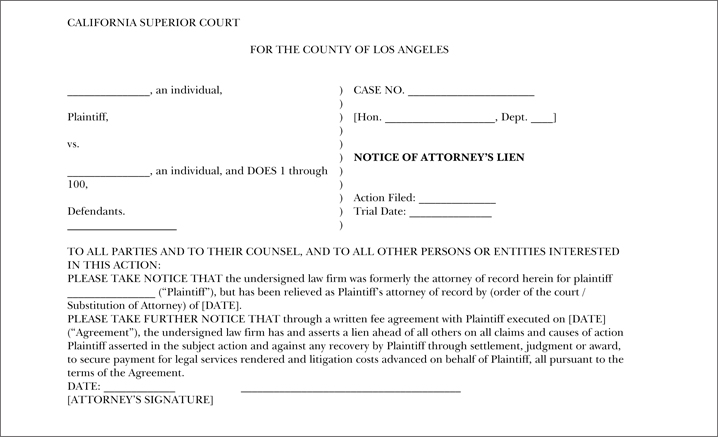Subbed out or subbed in
Issues relating to liens for attorneys’ fees
Plaintiff’s attorneys normally receive attorney fees and reimbursement of litigation costs advanced only when the case resolves through settlement, judgment or award. But the client has the absolute right to discharge his attorney at any time. Plaintiff’s attorneys can protect their right to receive fees for work performed by including an attorney’s lien provision in the retainer agreement. In the event the plaintiff’s attorney is discharged, she can serve notice of the attorney’s lien to the plaintiff’s new attorney (and to all interested parties).
Attorneys who substitute-in on a contingency basis must be aware of any lien by the prior plaintiff’s attorney. For both attorneys, no fees are due until the contingency – the plaintiff’s recovery through judgment, arbitration, or settlement – occurs. The prior attorney is limited to quantum meruit recovery for the reasonable value of services she rendered up to the point of the termination. Naturally, this limits the succeeding attorney’s fees to the total contingency fee, less the former attorney’s quantum meruit share.
Attorney’s lien
Protect your fee in the event you are discharged by including an attorney’s lien provision in your fee agreement. (See example in Appendix A.) An attorney’s lien – also called a charging lien – is created only through contract with the client. In a contingency fee agreement, the attorney’s lien formalizes the plaintiff attorney’s interest in his client’s recovery. The contingency attorney’s lien provision simply states that he has the right to recover his contractual attorney fees and litigation costs advanced through the client’s recovery. Ordinarily, the attorney’s lien is not an issue – assuming there is no dispute with the client over fees and costs. But the attorney’s lien protects the value of the attorney’s services in the event he is discharged or withdraws for “good cause.”
An attorney’s lien has priority over medical liens, and even survives the plaintiff’s bankruptcy. (Saltarelli & Steponovich v. Douglas (1995) 40 Cal.App.4th 1, 5-6.)
Notice of lien
If you are discharged as plaintiff’s attorney, serve a notice of lien on plaintiff and his new attorney, counsel for all parties, and all other interested parties known to you. (See Example in Appendix B.) File the Notice of Lien with the proof of service. In addition, send plaintiff’s new attorney an itemized detail of all litigation costs advanced.
If you succeed the discharged plaintiff’s attorney, notify your client of the former attorney’s notice of lien and litigation costs advanced. (Bar Ass’n of San Francisco Form.Opn. 1989-1.) Explain that, upon recovery by the plaintiff, the former attorney must be compensated for the reasonable value of her services and for the litigation costs she advanced. As the attorney succeeding to the plaintiff’s representation, you have a fiduciary duty to all lienholders, including the former plaintiff’s attorney. Therefore, if plaintiff recovers money through settlement, judgment, or award, you must notify the former plaintiff’s attorney of the recovery. Resolve the amounts payable to lienholders before distributing any of the plaintiff’s recovery.
Enforcing your attorney’s lien
If you are the former plaintiff’s attorney and have served and filed your notice of lien, you may enforce your lien through legal process if you are unable to negotiate an acceptable resolution of your lien with plaintiff and his new counsel. You may sue the plaintiff for breach of contract or declaratory relief under your original contingency agreement. Further, if the defendant or its insurer ignores your lien and pays the entire settlement or judgment to plaintiff and his new attorney, you may sue defendant and its counsel for intentional interference with the prospective economic advantage of a discharged attorney. (Levin v. Gulf Ins. Group (1999) 69 Cal.App.4th 1282, 1287-1288.)
Be aware of Mojtahedi v. Vargas (2014) 228 Cal.App.4th 974, 978, which applies the rule that a discharged attorney must sue the former client to establish the validity and enforceability of the lien before being able to sue successor counsel for failing to honor the lien. Of course, these claims can be joined in a single action.
If you are forced to withdraw from representing plaintiff for good cause, you may also assert and enforce your valid attorney’s lien. (Pearlmutter v. Alexander (1979) 97 Cal.App.3d Supp. 16, 19, 20 (disapproved on other grounds in Hensel v. Cohen (1984) 155 Cal.App.3d 563, 567-68).)
Quantum meruit recovery
The discharged plaintiff’s attorney is entitled only to the reasonable value of his services. (Fracasse v. Brent (1972) 6 Cal.3d 784, 790-91; Joseph E. Di Loreto, Inc. v. O’Neill (1991) 1 Cal.App.4th 149.) Quantum meruit recovery is not based on an amount due under a contract or to the “resulting benefit” of services performed. (Earhart v. William Low Co. (1979) 25 Cal.3d 503, 505 (includes services rendered to third persons at client’s request); Maglica v. Maglica (1998) 66 Cal.App.4th 442, 450-51 (services must be beneficial to justify quantum meruit recovery, but benefit may not be related to reasonable value of particular services rendered).)
The statute of limitations for quantum meruit claims is two years. (Code Civ. Proc., § 339 (action upon an obligation not founded on instrument of writing); see Maglica v. Maglica (1998) 66 Cal.App.4th 442, 452.)
Courts consider the circumstances of each case in determining the quantum meruit payment to the former attorney. The resulting “reasonable value of services rendered” may be different than the amount of any negotiated fee. (Cazares v. Saenz (1989) 208 Cal.App.3d 279, 287.) The former plaintiff’s attorney attempting to recover based on quantum meruit must show that she acted pursuant to an express or implied request from the plaintiff. (See Day v. Alta Bates Med. Ctr. (2002) 98 Cal.App.4th 243, 248-49); Huskinson & Brown, LLP v. Wolf (2004) 32 Cal.4th 453, 458.)
The quantum meruit analysis begins by calculating “the number of hours reasonably expended on the litigation multiplied by a reasonable hourly rate. This calculation provides an objective basis on which to make an initial estimate of the value of a lawyer’s services.” (Mardirossian & Assocs., Inc. v. Ersoff (2007) 153 Cal.App.4th 257, 272.) But in a contingency case, the quantum meruit amount may exceed the hourly rate times reasonable hours. This is because courts seek to account for the inherent risks of a contingency fee agreement. (Cazares, supra, 208 Cal.App.3d at pp. 287-88.)
If the former plaintiff’s attorney substantially performed the work contemplated by the contingency fee agreement, the entire contingency may be awarded to the former plaintiff’s attorney. (Fracasse v. Brent (1972) 6 Cal.3d 784, 791 (settlement on the courthouse steps achieved by former plaintiff’s attorney earned him the entire contingency fee amount). Where the former attorney performed only part of the work under the contingency agreement, some courts have apportioned the contingency fee pro rata, according to the value of legal services rendered by any attorney working on the case. (Cazares, supra, 208 Cal.App.3d at pp. 288-89.) The “pro rata” method is meant to allow the attorneys to realize the “benefit of the bargain” to the extent each has performed part of the work under the contingency agreement. (Id. at p. 290.)
(T)he trial judge must calculate a fraction where the numerator is the value of the legal services rendered by the particular attorney or firm at issue and the denominator is the aggregate value of all the legal services rendered by any attorney in the case. This may be as simple as adding up the total number of hours spent by all attorneys on the matter, but it is by no means limited to ‘straight time.’ The trial court may adjust the fraction upward or down- ward to account for difficulty of the work or other relevant factors.
(Id. at pp. 288-289.)
Handling client’s recovery when attorney’s lien is pending
If you are the succeeding plaintiff’s attorney and the former has asserted an attorney’s lien, you may not distribute the settlement, judgment or award without first satisfying the lien of the former plaintiff’s attorney. The usual rule requiring prompt distribution of such funds at the client’s request (CRPC 4-100(B)(4)) is suspended where an attorney claims an interest in those funds. (Matter of Kroff (Rev.Dept. 1998) 3 Cal. State Bar Ct.Rptr. 838, 853-54 (attorney promptly pursued fee arbitration to resolve dispute with clients); see Cal. State Bar Form.Opn. 2009-177 (where client and attorney cannot agree on disbursement, attorney has affirmative obligation to promptly seek resolution through arbitration or judicial determination).)
Interpleader
If you are unable to resolve the amount due the former plaintiff’s attorney (the lienholder), you may interplead the disputed funds with the court pursuant to Code of Civil Procedure section 386, et seq. See also Miller v. Rau (1963) 216 Cal.App.2d 68 and Los Angeles County Bar Association Professional Responsibility and Ethics Committee Formal Decision No. 478: July 18, 1994 (“Once the lien claim money is deposited with the court, the attorney is divested of any further responsibility for retention or distribution of the funds.”)
James R. Kristy

James R. Kristy is the principal trial attorney at The Kristy Law Firm, which he founded in 2003. At Whittier Law School, he served as Editor-in-Chief of the Whittier Law Review during 1999-2000. He has successfully prosecuted plaintiffs’ insurance-bad-faith cases during his entire legal career. Currently, he devotes his trial practice to representing consumers against insurers, employers, and medical institutions and practitioners. Since 2005, Kristy has served continuously as a member of the Board of Governors of the Consumer Attorneys Association of Los Angeles (CAALA).
Copyright ©
2026
by the author.
For reprint permission, contact the publisher: Advocate Magazine


